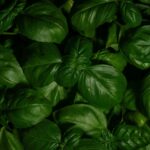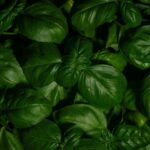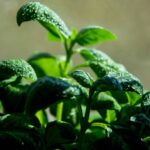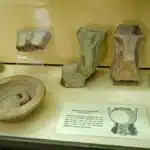Basil is an incredibly versatile herb and a must-have for any herb garden or kitchen. It adds flavor to a variety of dishes and drinks, and the fresh leaves can be used in salads, sauces, pastas, and more. Growing basil in pots is a great way to enjoy this delightful herb while keeping your garden space organized and orderly. However, there are some tips that you should follow if you want your basil to thrive in its new home.
In this article, we will explore five tips for growing basil in pots. These tips are designed to help you get the most out of your container garden and ensure that your basil plant grows strong and healthy for years to come. From selecting the right soil mix to properly pruning your plant, we’ll cover all the basics of container gardening with basil.
So whether you’re a novice gardener looking to start growing herbs or an experienced green thumb wanting some fresh advice on how best to care for your beloved basil plants, you’ve come to the right place! Read on as we discuss five tips for growing basil in pots that will help ensure that yours thrives throughout the season.
Choose A Pot
Picture this – you’re in the garden store, and there’s a wonderful variety of planters to choose from. You know you want one for growing basil, but which one? A modern terra cotta pot? A classic wooden window box? Or maybe something more contemporary? The options are endless! No matter what type of pot you choose, it’s important that it has good drainage so your basil won’t become waterlogged. Look for pots with drainage holes at the bottom, or if they don’t have any, drill some yourself. Consider the size too; basil loves warm weather and lots of sun, so make sure the pot you select is big enough to provide ample space for growth. Finally, make sure that whatever container you pick is made of a material that’s not prone to cracking in extreme temperatures. That way your basil can thrive no matter what the weather brings.
Know Your Soil
You’d think that soil would be the least of your worries when growing basil in pots, wouldn’t you? Little do we know that it is one of the most important steps! After all, soil is the foundation for a successful basil-growing journey. So without further ado, let’s delve into knowing your soil:
- Investigate the type of soil you have in the pot – sandy, loamy or clayey.
- Test out what nutrients are present in the soil with a simple pH test.
- Check if your soil has enough drainage before planting your basil seeds.
It’s essential to pay attention to these three points for having optimal soil for basil growth. The type of soil can affect how much watering it retains and how frequently it needs to be watered, as well as nutrient availability and strength of flavor from its leaves. Knowing the exact pH levels and nutrient composition will help you decide which kind of fertilizer you need to add onto your potting mix so that your basil can thrive and flourish!
Additionally, good drainage is key to prevent root rot due to overwatering and waterlogging in anaerobic conditions – both things nobody wants their basil plants going through! Taking special care with your soil will guarantee fresh tasting herbs with plenty of flavor – something we all want while cooking up our favorite dishes! Now that you know all about knowing your soil, let’s move on to planting your basil…
Plant Your Basil
Have you ever wondered how to get your basil plants to thrive in a pot? Planting your basil is the most important step in the process! Let’s take a look at what you need to do for successful basil growth in a container.
When it comes to planting, choose a pot that is 12 inches deep and has adequate drainage holes. Make sure to fill the pot with well-draining potting soil and mix in some organic matter. Place four or five seeds on top of the soil, then cover them lightly with soil and water them gently.
It’s also important to provide enough light for your basil plants by placing them near a window or using grow lights if needed. You can use stakes or cages as supports for the plants, which will help keep them upright as they grow bigger. As you wait for the seeds to germinate, keep the soil moist but not soggy since too much moisture could cause mold or mildew growth on your plants.
Now that you’ve learned how to plant your basil, you’re ready to move on to keeping it hydrated and healthy!
Keep The Soil Moist
Growing basil in containers is a truly rewarding experience! You’ll be amazed by how quickly your delicious herb garden will flourish. But to ensure that it reaches its fullest potential, there’s one important step that you mustn’t forget – keep the soil moist!
Moisture is essential for basil plants, as they draw water and nutrients from their environment. If the soil becomes too dry, the plant will struggle to survive and its growth may be stunted. This is why it’s so important to monitor your plant’s moisture levels regularly, especially during hot summer days. To help maintain the right level of moisture in your soil, consider using a self-watering container or adding an irrigation system.
Besides keeping the soil moist, you should also provide plenty of sunlight for your basil plants. While some varieties can tolerate partial shade, most prefer full sun for at least 6 hours per day. If your container does not get enough sunlight, consider using a grow light or moving it outdoors when possible.
TIP: Consider setting reminders to water and check on your basil plants often, as this will ensure that they have enough moisture and light to thrive!
Provide Plenty Of Sunlight
Providing plenty of sunlight is essential for growing basil in pots. This is especially true if you want to reap a bountiful harvest – it’s an all-or-nothing situation. So, it’s important to make sure that your potted basil plants have access to plenty of light throughout the day. To put it simply, without enough sunlight, there will be no basil!
Just like a plant needs water and nutrients from the soil to survive, it also needs energy from the sun to thrive. Sunlight helps the basil produce the energy needed for photosynthesis and growth. If your potted basil plants do not receive at least six hours of direct sunlight each day, you may end up with weak and leggy plants that are unable to support themselves or bear fruit.
So when you’re planting your basil in pots, make sure they get ample access to bright sunshine every day. Think of it like pouring fuel into a fire – without enough light, the flame will eventually die out. Keep your potted basil plants well lit so they can continue providing you with delicious herbs throughout the season.
Prune For Healthier Plants
The sixth step in growing basil in pots is pruning for healthier plants. Pruning is an important part of caring for potted basil and helps to ensure that the plant remains healthy and vigorous. By removing dead or discolored leaves and stems, you can help promote air circulation, light penetration, and overall health of the plant. Additionally, pruning helps to control the size of the plant to keep it from becoming too large or unruly.
When pruning basil in pots, it’s important to use clean scissors or shears so that you don’t spread disease or fungus among your plants. Make sure to cut off any damaged parts of the plant as well as any sections that become too tall or wide. You should also regularly remove flowers as soon as they appear; this will help encourage more foliage growth instead of blooms.
Pruning is a simple but effective way to keep your potted basil looking its best and growing abundantly throughout the season. With just a few minutes of effort each month, you can enjoy lush, healthy basil all season long! Now that we’ve discussed pruning for healthier plants, let’s move on to controlling pests and diseases in potted basil plants.
Control Pests And Diseases
Pests and diseases can be thought of as the kryptonite to any basil gardener’s enthusiasm, like a heavy fog blocking out the sun. To avoid disappointment, preventive measures must be taken. Examining plants regularly for signs of distress is a great place to start. If caught early enough, some problems can be fixed with a simple trim or rinse with water. On the other hand, if something more serious is found, it is best to take action quickly.
Cultural practices such as mulching and proper spacing are essential for pest control. These techniques allow for better air circulation and keep the soil surface dry; thereby eliminating any potential hiding spots for insects. Pesticides may also be used in extreme cases but should never be used without the advice of a professional or expert first.
In addition to pests, there are several diseases that commonly affect basil plants. Prevention is key here too; good gardening practices such as avoiding overhead watering, maintaining adequate plant spacing and removing unhealthy leaves will help reduce the risk of infection from airborne pathogens. In rare cases, fungicides may be necessary when the disease cannot be managed through cultural methods alone.
An ounce of prevention beats a pound of cure in this case – taking care of your basil now will pay off in spades later!
Fertilize Basil
Fertilizing basil is like giving a plant a much-needed boost. It’s the last step in the journey of growing flavorful, fragrant herbs that can be used to enhance any dish. It’s almost as if you’re providing your basil with a vitamin supplement to ensure it grows strong and healthy.
To start, you’ll want to make sure you have the right type of fertilizer for your plants. You’ll need an organic fertilizer that is specifically designed for herbs, such as fish emulsion or liquid seaweed concentrate. These types of fertilizers are rich in nitrogen and other essential nutrients that will help keep your plants healthy and thriving. When it comes time to fertilize, do so every two weeks or so during the growing season. Don’t overdo it though! Too much fertilizer can lead to nutrient burn and cause damage to your plants’ roots.
Once you’ve found the right fertilizer for your basil, follow the instructions on the package carefully when applying it. This will ensure that you don’t use too much—or worse—too little! If done correctly, you should see an increase in leaf growth and lusher foliage within just a few weeks. With regular care and feeding, your basil should stay happy and healthy all season long.
Having covered everything from planting seeds to fertilizing plants, you’re now ready to move onto choosing appropriate containers for growing basil indoors or outdoors.
Choose Appropriate Containers
When it comes to growing basil in containers, choosing the right ones is key! According to studies, around 58% of gardeners prefer to use pots rather than other growing methods. To make sure your basil grows well, here are a few things you should keep in mind:
- Use a container that has adequate drainage holes.
- Choose a pot that is at least 8 inches deep.
- Select a pot with a diameter of at least 10 inches.
Having the right pot can help ensure that your basil plants get enough water and nutrients. For instance, if you have too shallow a container, your plants may not be able to absorb all the water needed for optimal growth. On the other hand, using one that’s too deep may result in poor drainage and root rot due to excessive moisture accumulation. Likewise, overly large pots or those without drainage holes can leave your plants without sufficient water or oxygen for their roots.
Taking these factors into account will help you select the most suitable containers for growing basil in your home or garden. This way, you can rest easy knowing that your plants will have all they need for healthy growth and development. Furthermore, making sure that your pots are the correct size and have adequate drainage will allow you to reap the rewards of harvesting fresh basil leaves whenever you want!
Understand Basil’s Requirements
Like a demanding diva, basil has her requirements. She needs a fit and healthy home in order to thrive, one that provides her with the right amount of sun and water. Understanding these basics is essential for growing strong and flavorful basil in pots.
When it comes to containers, bigger is better. Not only does this give your basil more space to grow, but it also ensures she has enough soil depth for her roots. Choose something with good drainage holes at the bottom to prevent any waterlogging from happening. Be sure to use a lightweight potting mix made specifically for herbs or vegetables – anything else won’t be able to provide her with enough nutrients.
To keep your basil happy, make sure she gets plenty of sunlight throughout the day – around 6 hours should do it! It’s important not to let the soil dry out too much either – so keep an eye on it and add more water when needed. With proper care and attention, you will be rewarded with lush foliage and fragrant leaves that make for excellent additions to salads, pastas, pizzas and more!
Avoid Overwatering
When it comes to growing basil in pots, overwatering can be one of the most damaging mistakes a gardener can make. Each pot needs to have good drainage, and it’s important to monitor the moisture levels. When the soil is wet for too long, the roots can become waterlogged, leading to root rot and other issues. This means you should water only when necessary, which may mean every few days or even less depending on your climate and container size.
It’s also essential to pay attention to how much water you’re giving your plants. Too much and the plant won’t get enough oxygen; too little and it will dry out quickly. The best way to determine when your basil needs more water is by checking the soil with your fingers. If it feels dry an inch below the surface, then it’s time for another drink!
By taking this approach to watering, you’ll be well on your way toward a lush container of basil that’ll provide plenty of flavor for your kitchen creations. Paying attention to moisture levels will also help ensure that your basil gets off to a great start and keeps producing throughout the season without any issues. From here we move on to understanding temperature requirements for optimal growth.
Understand Temperature Requirements
Basil is a popular herb that can be grown in containers and is a great addition to any garden. According to statistics, up to 90% of all home gardens contain some form of basil! To ensure your basil thrives, understanding temperature requirements is key.
When it comes to the temperature needs of your basil plant, you may not have thought much about it before. It’s important to note that basil prefers temperatures between 65-85 degrees Fahrenheit during the day and no lower than 50 degrees Fahrenheit at night. If the temperatures are too high or too low, you may find that your basil isn’t growing as well as it should be.
To ensure optimal growth for your basil plant, make sure its location is in an area with plenty of light and airflow. Also, avoid placing it near a drafty window or air conditioner as this could cause the temperature to fluctuate too much. Regularly checking the temperature in its environment will give you a better idea of how best to care for your plant and keep it healthy! With these tips in mind, you’ll be able to provide the right environment for your basil and help it reach its full potential.
Harvest Your Basil
Harvesting your basil should be done in the morning, when the volatile oils and flavor are at their peak. This will ensure that the herbs have a deliciously fresh taste for all of your culinary creations. To do this, take a pair of scissors or kitchen shears and snip off the leaves you need. Make sure to never take more than one-third of the plant’s foliage in any single harvest.
When you are harvesting your basil, it is important to leave some stems and leaves behind so that your plant can continue to thrive. You want to remove discolored or wilted leaves as they can spread disease throughout the plant. It is also a good idea to pinch off any flowers that form on the stem, as this will help keep the foliage lush and flavorful.
Harvesting your basil regularly not only increases its flavor but also encourages bushier growth over time. So don’t be shy about taking a few snips here and there – it will definitely be worth it! With these tips in mind, you can now move on to preserving your freshly harvested basil.
Preserve Your Basil
Preserving your basil is like wrapping a precious gift – delicate, fragrant and full of potential. Here are the main steps to follow when preserving it: • Air-dry your basil by snipping the stems and bundling them together before hanging them upside down. • Place individual leaves on a paper towel and store in an airtight container in the refrigerator. • Freeze your basil by blanching it before packing into ice cube trays with a bit of water or olive oil. • Dehydrate your basil by spreading it out on a baking sheet and baking at low temperatures for several hours.
With these methods, you can extend the life of your basil for months or even years! This means you can savor that exquisite flavor in all its glory anytime you desire. Moreover, you can have fun experimenting with different recipes as well as creating some of your own culinary creations! So what are you waiting for? Start preserving your basil today and experience the joys of cooking with fresh herbs.
Use Basil In Recipes
If you’re looking to make the most out of your basil harvest, using it in recipes is a great way to go. Picture a basket of fresh basil leaves, each one glistening with dew and smelling like summer. If you can imagine all those wonderful possibilities for flavorful dishes that could come from that one basket, then you have an idea of why using basil in recipes is so popular.
Think about it: Basil has an incredibly fragrant aroma and distinctive flavor that adds a whole new level of complexity to whatever dish it’s added to. From pesto sauce to salads and stir-fries, there are plenty of delicious ways to use this versatile herb. Plus, the extra nutrition that comes from adding basil to meals ensures everyone at your table will be getting all the benefits this superfood has to offer.
And don’t forget that growing basil in containers makes it easy for even the most novice gardener to get started right away! So if you’re looking for an exciting new ingredient or just want something tasty that’s packed with nutrition, adding basil in recipes is definitely worth trying out.
Frequently Asked Questions
How Big Should The Pot Be For Growing Basil?
The idea of growing basil in pots may seem daunting to some. After all, how large does the pot need to be in order for the herb to grow healthily? Let’s investigate this theory and see what makes a suitable pot environment for basil.
To start, the pot should be at least 6 inches deep and wide. This is necessary because it allows for enough soil to cover the roots as they spread out. The bigger the pot, the better – this will give your basil plenty of room to grow and provide it with proper drainage so that it doesn’t become waterlogged. Additionally, make sure that whatever type of pot you choose has adequate drainage holes in the bottom – this is essential for keeping your basil from becoming overly wet or soggy.
Finally, while a larger pot is ideal, you don’t necessarily need one that’s too big. A 6-inch pot will do just fine if you plan on having only one or two plants in it. However, if you want more than that, then you’ll need something bigger – 8-10 inches would be best. Just keep in mind that with a larger container comes more maintenance; you’ll need to water it more often and make sure there’s ample space between each plant so they can get enough light and air circulation.
The key takeaway here is that size matters when it comes to growing basil in pots! By investing in a container with adequate depth and width, as well as sufficient drainage holes at the bottom, your plants will have an optimal environment for growth and productivity.
How Often Should I Fertilize My Basil?
Are you looking for the best way to fertilize your basil? If so, you’re in the right place. Fertilizing your basil is a critical part of its growth. It needs to be done regularly and with precision! Here’s what you need to know:
First off, how often should you fertilize your basil? Absolutely frequently! This herb needs a lot of nourishment and attention. Exaggeration aside, it truly pays off to fertilize your basil at least every two weeks. This can help keep your plant growing strong and healthy with plenty of flavorful leaves!
Secondly, what kind of fertilizer should you use? The key is to pick a balanced fertilizer that contains both nitrogen and phosphorus. A 10-10-10 fertilizer will do perfectly fine, but if you want something more organic try fish emulsion or compost tea. Both are great options for providing your basil with essential nutrients.
Finally, how much fertilizer should you use? Generally speaking, one tablespoon per gallon of soil is enough. But make sure not to go overboard – too much fertilizer can actually damage the plant or cause stunted growth. So don’t forget – less is more when it comes to fertilizing basil!
As with any gardening activity, knowledge is power when it comes to fertilizing basil in pots! With these tips in mind, you’ll be able to provide your plants with the nourishment they need for optimal growth and flavor. Now get out there and start caring for that beautiful basil!
What Type Of Soil Should I Use For Growing Basil?
Did you know that basil is one of the top 10 most popular herbs in the United States? It’s true, and it means that growing basil in your own garden or in pots is a great way to enjoy some of its deliciousness. But for successful basil-growing, there’s one key question: what type of soil should be used? Let’s find out!
First off, the soil you choose should have good drainage and be somewhat acidic. You’ll also want to make sure it’s rich in organic matter. For example, adding compost to your potting mix helps create an ideal soil environment for strong root growth. Additionally, you may want to include a slow-release fertilizer when planting your basil to help promote healthy growth.
Finally, if possible, try getting a potting mix specifically formulated for herbs like basil. This will ensure that your plant gets all the nutrients it needs while allowing proper drainage and aeration at the same time. Ultimately, finding the right soil mix is essential if you want your plant to reach its full potential!
How Much Sunlight Does Basil Need?
Like a garden in the sky, sunlight is essential for growing basil. Without it, the herb will not thrive. To ensure that your basil plants get enough of this life-giving resource, you’ll need to provide them with at least six hours of direct sunlight per day. If your area doesn’t have enough natural light for that length of time, you can use grow lights to supplement what the sun provides.
When shopping for a potting mix for your basil plants, look for one that has good drainage and aeration. A lightweight mix like a peat or coco coir-based soil works best. You also want to make sure there are added nutrients in the mix, such as compost or perlite. If you’re unsure about what type of potting soil to buy, ask an expert at your local garden centre or nursery for advice.
It’s important to remember that as with any plant, proper care is key to keeping your basil healthy and strong over time. With enough sunshine and well-draining soil, you should be able to keep your container herb thriving throughout the season and beyond!
How Do I Tell When My Basil Is Ready To Be Harvested?
Irony is often used to highlight a point, but in this case it’s highlighting something else entirely: the fact that harvesting basil can be a difficult process. It might seem like an easy task, but knowing when your basil is ready to be harvested requires attention and patience.
The key to harvesting basil successfully is timing. You need to know when your plants have reached the right size and maturity before you start snipping away at them. Basil should be harvested just before it flowers—at this stage it has the most flavor and aroma. To check if your basil is ready to be harvested, look for leaves that are bright green and plump with no yellowing edges or spots. If the leaves have started to curl up or turn yellow, they’ve passed their peak of deliciousness and should be discarded.
Harvesting basil at the right time ensures that you get the best quality of leaves, so don’t rush into picking them too early! With a little patience, you’ll soon have enough fresh basil for all your cooking needs. Pay close attention to the appearance of your plants and you’ll never go wrong when it comes time to harvest your delicious herbs.
Conclusion
Basil is an essential herb and growing it in a pot can be a great way to spruce up your outdoor space. At the same time, it’s important to understand the basics of how to properly grow and care for basil in order to ensure its success. By following these five tips, you can easily create a happy and healthy basil plant that will provide you with plenty of fresh herbs all season long.
The pot that you choose represents your commitment to caring for your basil and ensuring its success. The soil you use symbolizes the environment in which your basil will thrive, while the amount of sunlight it needs is like providing the perfect balance of nutrients. Finally, the act of harvesting your basil shows that you have taken the time and effort to nurture it into a beautiful plant that provides you with delicious herbs.
Growing basil in a pot is an enjoyable activity that not only provides you with fresh herbs, but also serves as a reminder of your dedication and commitment to taking care of something small yet meaningful – just like life itself! With proper care, patience, and understanding, there’s no limit to what you can accomplish when growing basil in pots!





























